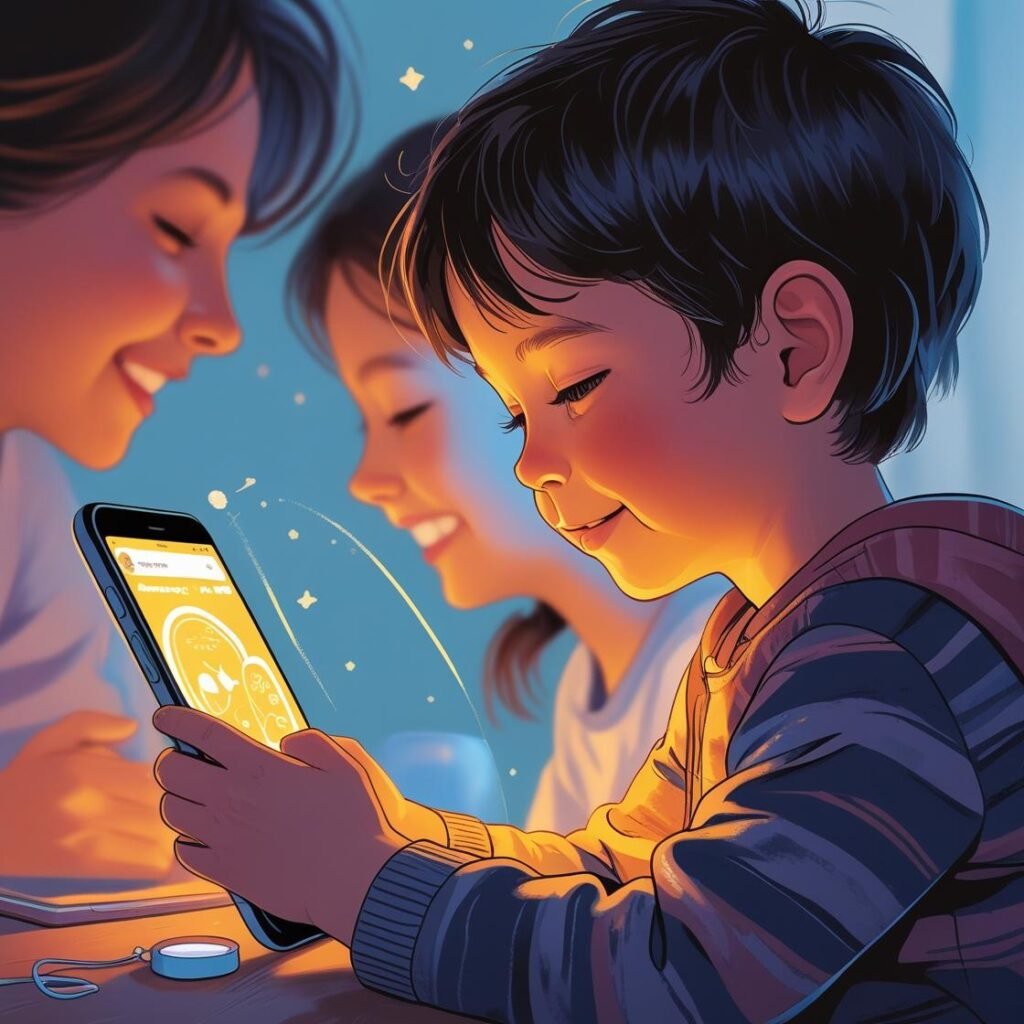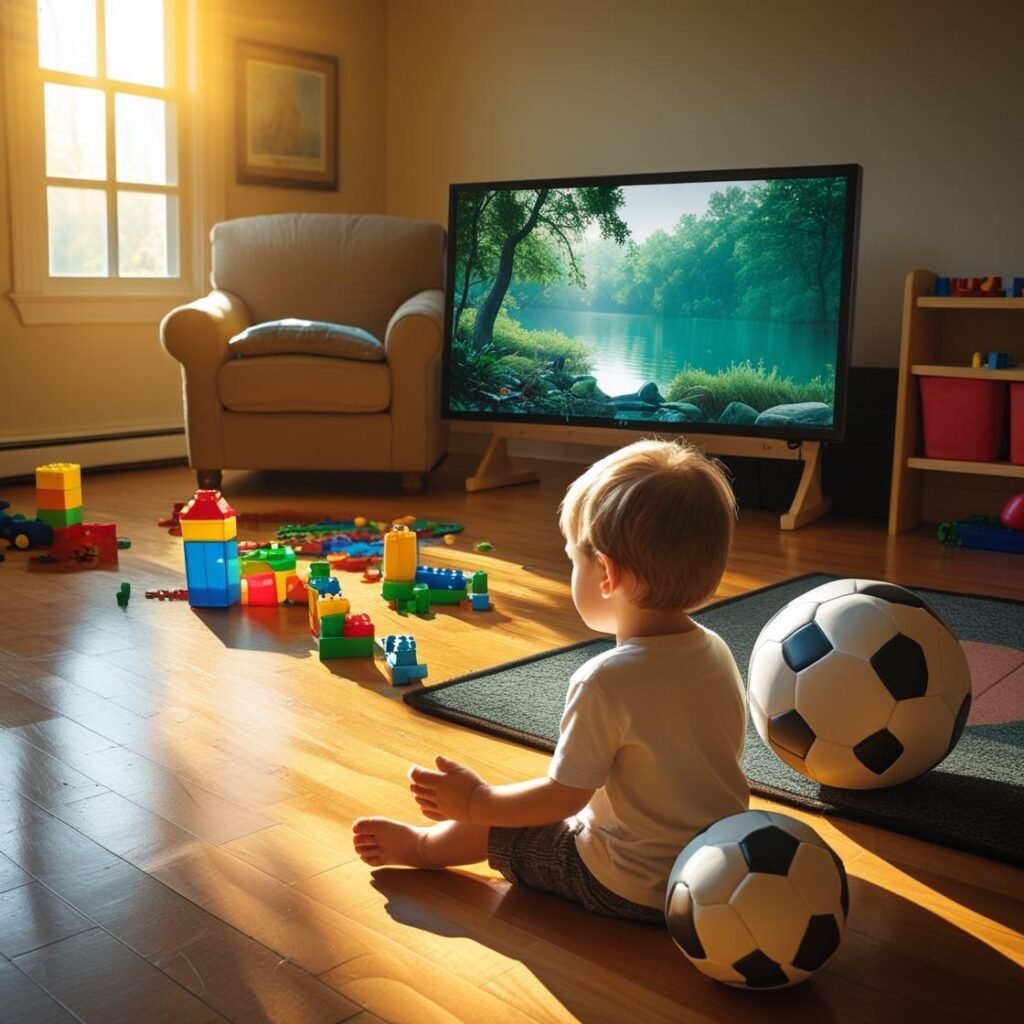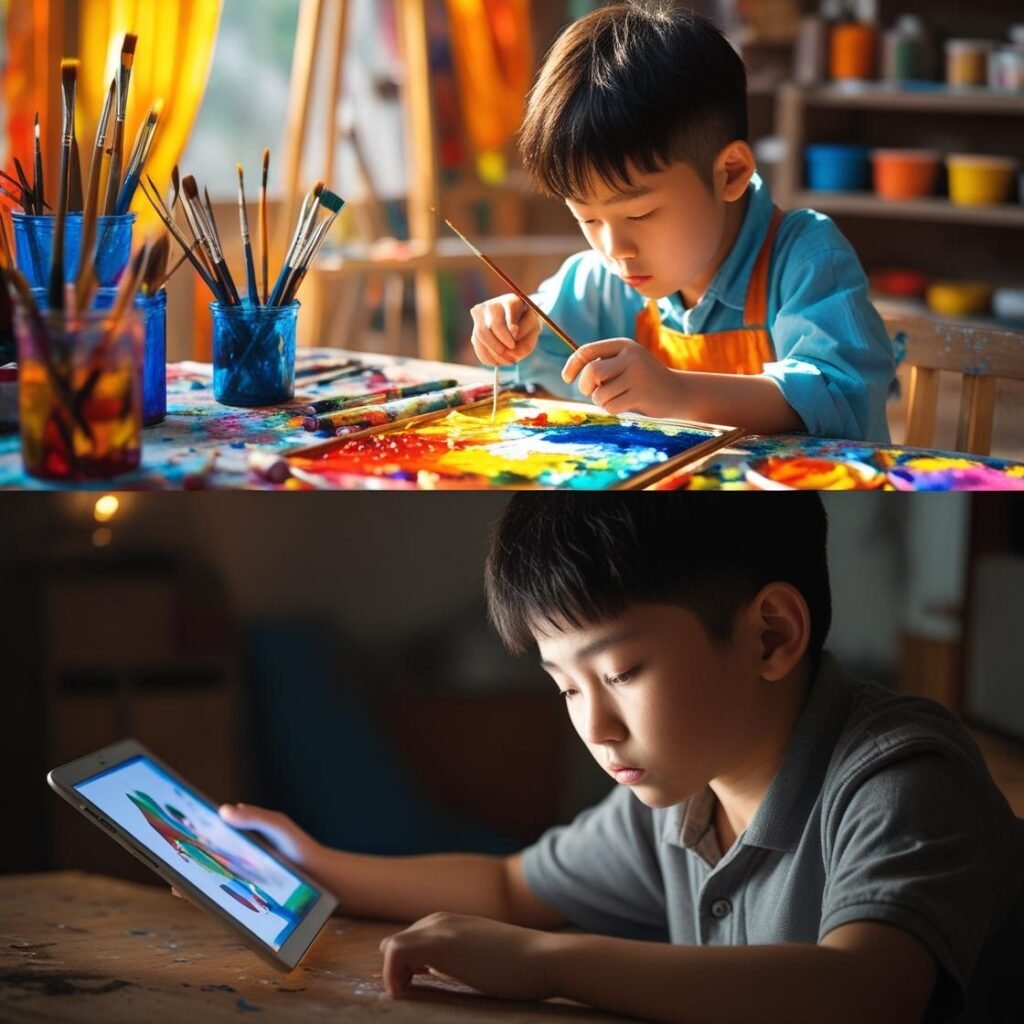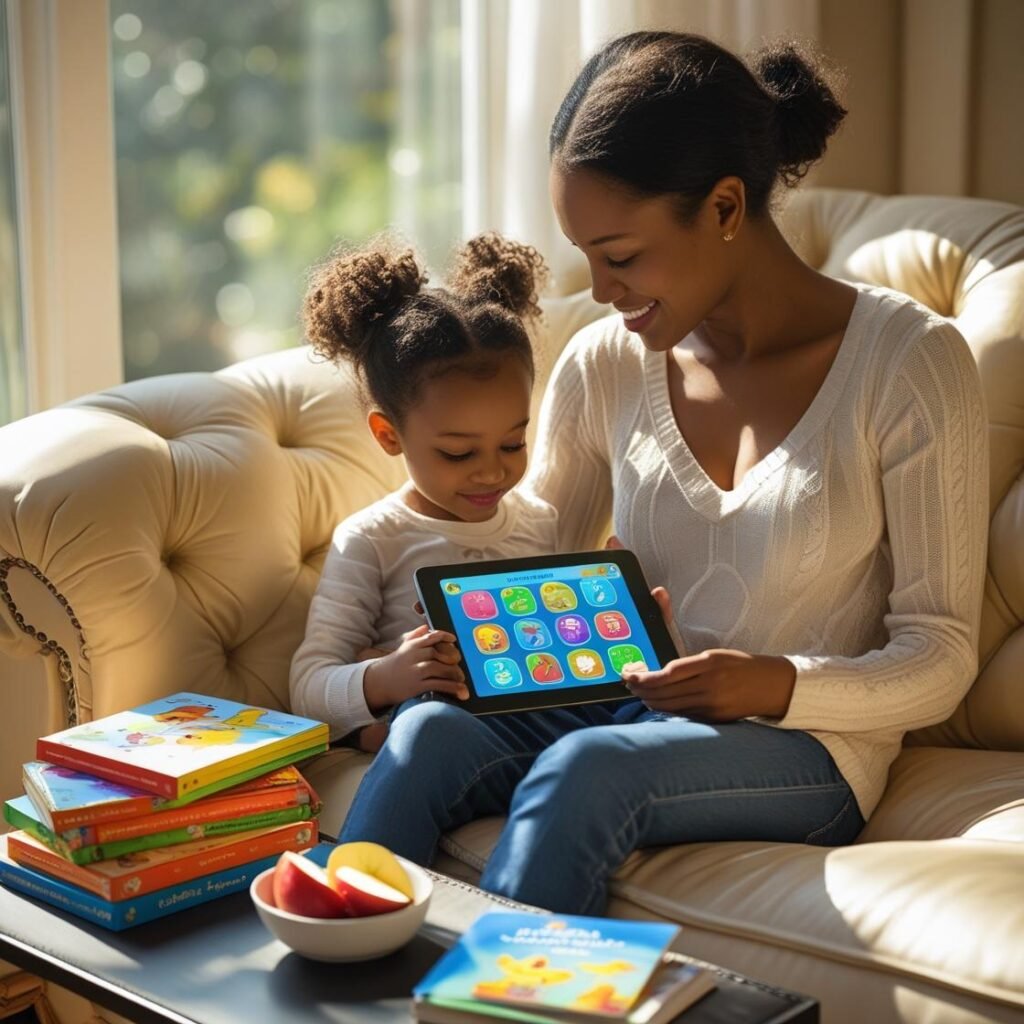Table of Contents
When I Saw My Son Arjun Fade Behind the Screen

It began with something seemingly harmless. One evening, I called out to Arjun—my playful, curious 8-year-old—that dinner was ready. No answer. Thinking he hadn’t heard me, I walked over. There he sat—cross-legged on the couch, eyes fixed on his tablet, the glow of a video lighting up his face. I called him again. Still nothing. My heart sank. That wasn’t just distraction. That was disconnection. That was the beginning of a deep child screen impact.
Arjun used to be the kind of boy who’d chase butterflies, ask about the stars, and narrate imaginative stories about superheroes and dragons. But lately, the sparkle in his eyes was dimming. He wasn’t talking much. He wasn’t laughing as often. He was drifting.
And suddenly, “child screen impact” wasn’t just a phrase on a parenting blog—it had walked into my home and taken a seat at my dinner table.
The Quiet Disappearance of My Son
As days passed, the signs grew louder in their silence. Arjun stopped showing interest in playing outside. His soccer ball remained deflated in the corner. His once-favorite puzzles gathered dust. He would sit in one spot for hours, lost in endless cartoons, gaming videos, or random content on YouTube Kids.

He started resisting schoolwork. I would try to help him with math or reading, and he’d say, “It’s too hard,” and ask for his tablet instead. His frustration threshold had dropped. His attention span? Barely five minutes.
One day, he missed his best friend’s birthday party, choosing instead to “level up” in a mobile game. That hurt. It wasn’t just about screens anymore—it was about losing real-world joy. My son was slowly disappearing into the digital world due to child screen impact
As a mother, the guilt was overwhelming. I had used screens as babysitters when I was busy. I had allowed “a few more minutes” that turned into hours. I had overlooked signs, thinking they were just phases.
But this wasn’t a phase. It was the result of a very real and growing problem—what I now understand deeply as child screen impact.
What Is the Real Child Screen Impact?
Child screen impact refers to the mental, emotional, behavioral, and physical consequences children face due to excessive or unregulated screen time. It’s not about occasional use—it’s about dependency, overstimulation, and detachment from the real world.
Here’s what I observed and learned:
🧠 Reduced Attention Span: Arjun could no longer focus on a single task for more than a few minutes.

😟 Emotional Outbursts: Minor frustrations led to major meltdowns.
🛌 Sleep Disturbances: His sleep was shallow, delayed, and irregular—likely due to late-night screen exposure.
🧍♂️ Social Withdrawal: He avoided real-life interaction, preferring screen characters over classmates.
📉 Academic Struggles: He was forgetting basics, skipping reading, and resisting anything that required concentration.
😔 Lack of Creativity: His storytelling and imaginative play vanished, replaced by mimicking what he saw online.
Experts say the human brain, especially in children, is highly neuroplastic—it molds itself based on experiences. Excessive passive screen time floods the brain with high stimulation but low cognitive engagement. Over time, the brain starts craving only that kind of input. Everything else—reading a book, solving a puzzle, building a toy—feels too slow, too hard.
In Arjun, I saw this shift happening. And I knew I had to act.
The 5 Steps I Took to Reverse Child Screen Impact
Step 1: A Full Weekend Digital Detox
I told Arjun we were having a “no screen weekend.” His reaction? Full-blown panic. Tears. Shouting. Refusal to eat.
But I stayed calm. I brought out board games, puzzles, old crayons, and Lego blocks. We made paper rockets. We danced to old songs. We baked banana muffins. Slowly, something shifted.
By Sunday evening, he smiled and said, “That was fun.”
It was the first time in months I had heard that tone.
💡 Parenting Tip: Start small. One weekend. Make it exciting. Turn it into a challenge with fun rewards.
Step 2: Replacing Mindless With Meaningful
I knew cold turkey wasn’t sustainable. Screens weren’t the enemy—unregulated use was. So I installed Focus Fun—a screen control and learning encouragement app. It blocked mindless videos and allowed only educational content, creativity boosters, and age-appropriate interactive lessons.
Now, screen time wasn’t just time-passing—it was time-growing.
Arjun explored math games, animated science stories, and spelling challenges. And surprisingly, he began to enjoy them.
💡 Parenting Tip: Don’t just remove screens. Replace them with digital tools that serve your child’s growth.
Step 3: Rebuilding Family Moments
We reinstated screen-free dinners. No phones, no distractions. We lit candles, told jokes, asked questions. At bedtime, we started a storytelling tradition: one night I told a story, the next night Arjun did.
His stories were clumsy at first. But they grew imaginative. And soon, he asked, “Can we write these stories down?”
My heart swelled.
💡 Parenting Tip: Family routines beat any fancy gadget. Reconnect over meals, walks, or made-up fairy tales.
Step 4: Creating a Balanced Daily Routine

We sat down together and made a new routine. It had art time, reading hour, outdoor play, screen time (only 30 minutes, learning apps only), and snack breaks.
Having structure gave Arjun stability. He started waking up excited. He began completing homework without reminders. He even started helping with chores!
💡 Parenting Tip: Let kids co-create their routines. Involvement leads to ownership.
Step 5: Progress Tracking Through Positivity
We used a “Focus Chart.” Every screen-free day earned a star. Every learning activity earned a sticker. At the end of each week, we celebrated with a “Yes Day” (within limits).
Arjun loved seeing the chart fill up. It turned accountability into a game, not punishment.
💡 Parenting Tip: Celebrate small wins. Replace fear with fun in your parenting tools.
What Changed—And What Didn’t
The tantrums didn’t vanish overnight. There were days he cried for the tablet. There were setbacks. But the momentum had shifted. I was no longer watching my child disappear. I was watching him return.
He laughed more. He hugged more. He asked questions again—about clouds, about ants, about why the moon changes shape. His grades improved. His friends came over more often. He started drawing rocket ships again.
And one evening, he looked at me and said, “I like it when you play with me more than the tablet.”
That moment… it was everything.
What Every Parent Should Know
You don’t have to be perfect. I wasn’t. You don’t need to go tech-free. That’s unrealistic. But you can go tech-smart.

Here’s what I’ve learned:
- Screens are part of life. But they should never replace it.
- Behavior changes are the first red flag. Don’t ignore them.
- Don’t wait for school complaints. Act early.
- Use apps that help, not hurt. Focus Fun worked for us.
- Connection is the antidote to disconnection. Start there.
Final Thoughts: From Regret to Renewal
Writing this wasn’t easy. It meant owning up to my parenting mistakes. But I share this not out of guilt—but out of hope.
The child screen impact is real. It creeps in slowly but can take away what matters most—your child’s spark, their curiosity, their connection with you.
But here’s the powerful truth: You can bring it all back.
Not in a single day. Not without struggle. But step by step, moment by moment.
Today, I see Arjun—not just physically, but emotionally. He’s here. With me. Growing, learning, smiling again.
And if you’ve seen signs in your home—withdrawal, tantrums, delay in development—it’s not too late. You have the power to reverse it. To re-engage. To rebuild.
Because no screen can replace a parent’s presence.
So unplug the noise. Plug into what matters.
Your child is waiting—for you.
FAQ’s
1. What Is the Meaning of Child Screen Impact?
Child Screen Impact refers to how excessive screen exposure affects a child’s mental, emotional, physical, and social development. It includes issues like reduced attention span, behavioral changes, sleep disturbances, and emotional disconnection. Understanding the child screen impact helps parents take timely corrective action.
2. How Does Screen Time Affect My Child’s Brain?
The child screen impact on the brain is significant—studies show it can disrupt cognitive development, memory retention, and emotional regulation. Prolonged screen use alters neural pathways and reduces time spent on real-world learning and social interaction.
3. Can the Child Screen Impact Be Reversed?
Yes, the child screen impact is reversible in many cases with prompt action. Reducing screen time, encouraging real-world play, and using tools like the Focus Fun app can help children regain focus, creativity, and emotional connection.
4. Why Should Parents Worry About Child Screen Impact Early On?
Early screen exposure can shape lifelong habits. The child screen impact is more intense in developing brains, affecting learning ability, social skills, and self-regulation. Early awareness and digital boundaries are key for healthy childhood growth.
5. What Role Does the Focus Fun App Play in Reducing Child Screen Impact?
The Focus Fun app helps reduce child screen impact by monitoring screen time, blocking non-educational distractions, and promoting learning-based activities. It empowers parents to guide screen habits without constant conflict.
6. How Much Screen Time Is Too Much for Kids?
Experts recommend no more than 1–2 hours of recreational screen time per day for children aged 6 and older. Toddlers and preschoolers should have even less. Quality of content and parental engagement also matter, not just the duration.
7. What Are Signs My Child Is Addicted to Screens?
Common signs include tantrums when screens are removed, skipping meals or sleep to stay on devices, avoiding social interaction, and losing interest in toys or outdoor play. If these behaviors persist, it may be time to reassess screen habits.
8. Can Screen Use Affect School Performance?
Yes. Excessive screen exposure can reduce attention span, impact memory retention, and cause sleep problems—all of which can lower academic performance. Screens also compete with homework time, reducing study consistency.
9. How Can I Create a Healthy Screen Routine at Home?
Start by setting device-free zones (like the dinner table), establish clear screen-time rules, use timers, and co-watch or co-play when possible. Reward screen-free activities and make offline hobbies a daily part of the schedule.
10. Is It Okay to Use Screens as a Reward or Punishment?
Using screens as a reward can create emotional dependency, while using them as punishment can make them seem even more desirable. Instead, focus on natural consequences and emphasize balance by integrating screens into healthy routines.
